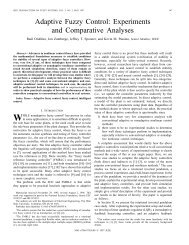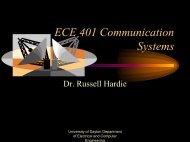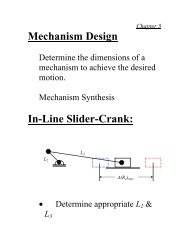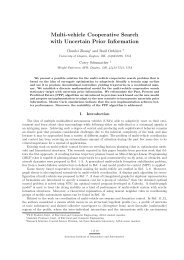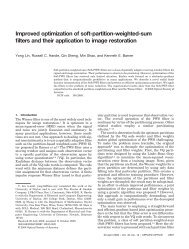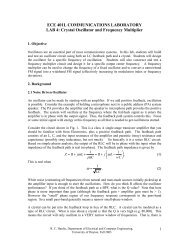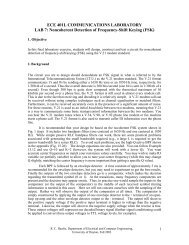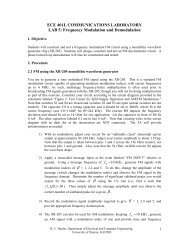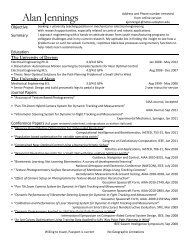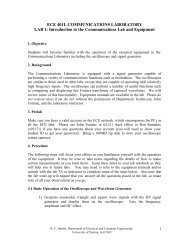here - University of Dayton : Homepages
here - University of Dayton : Homepages
here - University of Dayton : Homepages
Create successful ePaper yourself
Turn your PDF publications into a flip-book with our unique Google optimized e-Paper software.
Saturday 3:50–4:15 109 Oelman Hall<br />
Results on Generalized Powers <strong>of</strong> Graphs<br />
Yang Xiang<br />
Kent State <strong>University</strong><br />
Abstract<br />
We will present our results on ”Generalized Powers <strong>of</strong> Graphs and Their Algorithmic Use”. We will<br />
introduce two new types <strong>of</strong> coloring <strong>of</strong> graphs, which generalize the well-known Distance-k-Coloring.<br />
The motivation comes from the frequency assignment problem in heterogeneous multihop radio networks,<br />
w<strong>here</strong> different radio stations may have different transmission ranges. Let G = (V, E) be a<br />
graph modelling a radio network, and assume that each vertex v <strong>of</strong> G has its own transmission radius<br />
r(v), a nonnegative integer. We define r-coloring (r + -coloring) <strong>of</strong> G as an assignment Φ : V ↦→ 0, 1, 2, ...<br />
<strong>of</strong> colors to vertices such that Φ(u) = Φ(v) implies dG(u, v) > r(v) + r(u) (dG(u, v) > r(v) + r(u) + 1,<br />
respectively). The r-Coloring problem (the r + -Coloring problem) asks for a given graph G and a<br />
radius-function r : V ↦→ N ∪0, to find an r-coloring (an r + - coloring, respectively) <strong>of</strong> G with minimum<br />
number <strong>of</strong> colors. Using a new notion <strong>of</strong> generalized powers <strong>of</strong> graphs, we investigate the complexity<br />
<strong>of</strong> the r-Coloring and r + -Coloring problems on several families <strong>of</strong> graphs, such as k-chordal graphs,<br />
weakly chordal graphs, AT-free graphs, co-comparability graphs, interval graphs, circular arc graphs<br />
and strongly chordal graphs. Most <strong>of</strong> these results were obtained in collaboration with Andreas<br />
Brandstädt, Feodor Dragan and Chenyu Yan.<br />
Saturday 4:15–4:40 109 Oelman Hall<br />
Collective tree spanners <strong>of</strong> special classes <strong>of</strong> graphs<br />
Chenyu Yan<br />
Kent State <strong>University</strong><br />
Abstract<br />
We say that a graph G = (V, E) admits a system <strong>of</strong> µ collective additive tree r-spanners if t<strong>here</strong> is<br />
a system T (G) <strong>of</strong> at most µ spanning trees <strong>of</strong> G such that for any two vertices x, y <strong>of</strong> G a spanning tree<br />
T ∈ T (G) exits such that dT(x, y) ≤ dG(x, y)+r. In this talk, we give a survey <strong>of</strong> the recent results on<br />
collective tree spanners problem. In particular, we will present the results <strong>of</strong> collective tree spanners on<br />
chordal, AT-free related, homogeneously orderable graphs and graphs with bounded chrodality, tree<br />
width and clique-width. Among other results we show that<br />
• Every chordal graph admits a system <strong>of</strong> O(log n) collective additive tree 2-spanners.<br />
• Every AT-free graphs admits a system <strong>of</strong> 2 collective additive tree 2-spanners.<br />
• Every homogeneously orderable graph admits a system <strong>of</strong> O(logn) collective additive tree 2spanners.<br />
• Every k-chordal graph admits a system <strong>of</strong> O(log n) collective additive tree ⌊(k +1)/3⌋-spanners.<br />
All the above collective tree spanners can be constructed in polynomial time. This is joint work with<br />
Derek G. Corneil and Feodor F. Dragan.<br />
14



